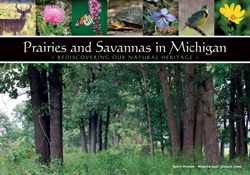By Eric Freedman
Ryan O’Connor, Michael Kost and Joshua Cohen direct their attention to a life-and-death struggle on land.
In their profusely illustrated “Prairies and Savannas in Michigan: Rediscovering Our Natural Heritage” (Michigan State University Press, $24.95) the three ecologists explore the history and future of two vital ecosystems.
Prairies are dominated by broad-leaved plants and grasses with few trees. Savannas are habitats between forest and prairie with a partial canopy of trees.
In the first half of the 1800s, savannas and prairies covered 7 percent of the state, primarily in the southern third of the Lower Peninsula. Fires, whether started by lightning or by Native Americans, maintained the openness of the land and its ability to regenerate and support wildlife.
Today, however, their survival is in jeopardy. Largely to blame are farming, logging, development, drainage systems, overuse of groundwater and the absence of fire, according to the authors, who work for the Michigan Natural Features Inventory.
Invasive species such as purple loosestrife, buckthorn and garlic mustard also play a damaging role
In Oakland County — “named for its historic, stately oak openings” — remaining patches of savanna are being converted to housing developments.
And Prairie Ronde once covered more than 300 square miles of Kalamazoo County. Now its prairie has shrunk to “three isolated remnants,” with “only a handful” of once-profuse oak openings left.
“Tiny, tattered pieces of these lost landscapes can still be found in the unmowed portions of old cemeteries, on open hillsides and along railroad tracks, which were formerly maintained by fires sparked from passing trains,” they write.
The book also discusses the need for restoration and preservation projects, such as controlled burnings, controlling invasive species and allowing beaver to return and build dams. As an example, it cites the Nature Conservancy’s Ives Road Fen preserve in Lenawee County, where hundreds of volunteers have worked to restore biodiversity.
Prairies and savannas “serve as natural open space, important habitat for rare species, areas for recreation, sites for educational study and places of spiritual inspiration,” the authors say.
© 2009, Capital News Service, Michigan State University School of Journalism. Not to be reproduced without permission.

The fractionalizing of continuous ecosystems does more to diminish habitats than any other past threat to animals and plants. Man’s voracious appetite for developing wild lands and changing their character to what suits us, has to stop. Only climate change will be more damaging and that, of course, is another one of our insults to the natural world.
What other animal is capable and willing to despoil it’s own habitat to the extent that it may jeopardize it’s own existence? None, but Man.
Great Book!